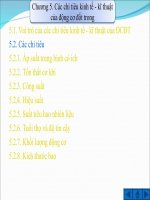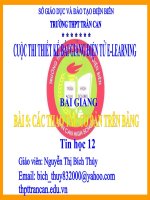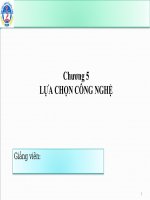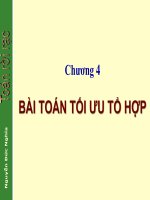Bài 5 Slide decision trees Machine Learning
Bạn đang xem bản rút gọn của tài liệu. Xem và tải ngay bản đầy đủ của tài liệu tại đây (1.68 MB, 47 trang )
Decision Trees
Function Approximation
Problem Setting
•
•
Set of possible instances
Set of possible labels
•
Unknown target function
•
Set of function hypotheses
f :X !
Y
H = {h | h : X !
Y}
n
Input:
Output:
Training examples of unknown target function f
h
Hypothesis
{hx
i , y i i }i = 1
H
that
approximates
f
=best
{hx
1 , y 1 i , . . . , hxn , y n i }
Sample Dataset
•
•
•
Columns denote features X i
Rows denote labeled instances
Class label denotes whether a tennis game was played
xi , y i
xi , y i
Decision Tree
•
A possible decision tree for the data:
•
Each internal node: test one attribute X i
•
•
Each branch from a node: selects one value for X i
Each leaf node: predict Y
Based on slide by Tom Mitchell
(or
p( Y
| x 2 leaf)
)
Decision Tree
•
A possible decision tree for the data:
•
What prediction would we make for
<outlook=sunny, temperature=hot, humidity=high, wind=weak> ?
Based on slide by Tom Mitchell
Decision Tree
• If features are continuous, internal nodes can test the value of a feature
against a threshold
6
Decision Tree Learning
Problem Setting:
•
Set of possible instances X
–
–
•
e.g., <Humidity=low, Wind=weak, Outlook=rain, Temp=hot>
Unknown target function f : XY
–
•
each instance x in X is a feature vector
Y is discrete valued
Set of function hypotheses H={ h | h : XY }
–
each hypothesis h is a decision tree
–
trees sorts x to leaf, which assigns y
Stages of (Batch) Machine Learning
n
X , Y = {hxi , yi
Given: labeled training data
•
i } Assumes each
xi ⇠ D (X )
i =1
with y i = f
target
( xi )
Train the model:
learner
X, Y
model classifier.train(X, Y )
x
Apply the model to new data:
•
Given: new unlabeled instance
D (X )
x⇠
model
yprediction
Example Application:
Section Risk
Based on Example by Tom Mitchell
A Tree to Predict Caesarean
Decision Tree Induced Partition
Color
blue
green
red
Size
big
+
small
-
Shape
square
+
round
Size
big
-
+
small
+
Decision Tree – Decision Boundary
•
•
Decision trees divide the feature space into axis- parallel (hyper-)rectangles
Each rectangular region is labeled with one label
– or a probability distribution over labels
Decision
boundary
11
Expressiveness
•
Decision trees can represent any boolean function of the input attributes
Truth table row path to leaf
•
In the worst case, the tree will require exponentially many nodes
Expressiveness
Decision trees have a variable-sized hypothesis space
•
As the #nodes (or depth) increases, the hypothesis space grows
–
–
Depth 1 (“decision stump”): can represent any boolean function of one feature
Depth 2: any boolean fn of two features; some involving three features (e.g., (x 1
_ (¬x 1 ^ ¬x 3 )
–
etc.
Based on slide by Pedro Domingos
)
^ x 2)
Another Example: Restaurant Domain
(Russell & Norvig)
Model a patron’s decision of whether to wait for a table at a restaurant
~7,000 possible cases
A Decision Tree from
Introspection
Is this the best decision tree?
Preference bias: Ockham’s Razor
•
Principle stated by William of Ockham (1285-1347)
–
–
–
Idea:
“non sunt multiplicanda entia praeter necessitatem”
entities are not to be
multiplied beyond necessity
AKA Occam’s Razor, Law of Economy, or Law of Parsimony
The simplest consistent explanation is the best
• Therefore, the smallest decision tree that correctly classifies all of the training
examples is best
•
•
Finding the provably smallest decision tree is NP-hard
...So instead of constructing the absolute smallest tree consistent with the training examples,
construct one that is pretty small
Basic Algorithm for Top-Down Induction of Decision
Trees
[ID3, C4.5 by Quinlan]
node = root of decision tree Main loop:
1.
A the “best” decision attribute for the
next node.
2.
3.
Assign A as decision attribute for node.
For each value of A, create a new
descendant of node.
4.
5.
Sort training examples to leaf nodes.
If training examples are perfectly classified, stop. Else, recurse over new leaf nodes.
How do we choose which attribute is best?
Choosing the Best Attribute
Key problem: choosing which attribute to split a given set of examples
•
Some possibilities are:
–
–
–
–
Random: Select any attribute at random
Least-Values: Choose the attribute with the smallest number of possible values
Most-Values: Choose the attribute with the largest number of possible values
Max-Gain: Choose the attribute that has the largest expected information gain
•
•
i.e., attribute that results in smallest expected size of subtrees rooted at its children
The ID3 algorithm uses the Max-Gain method of selecting the best attribute
Choosing an Attribute
Idea: a good attribute splits the examples into subsets that are (ideally) “all positive” or “all
negative”
Which split is more informative: Patrons? or Type?
Based on Slide from M. desJardins & T. Finin
ID3-induced
Decision Tree
Based on Slide from M. desJardins & T. Finin
Compare the Two Decision Trees
Based on Slide from M. desJardins & T. Finin
Information Gain
Which test is more informative?
Split over whether Balance
is employed
exceeds 50K
Less or equal 50K
Split over whether applicant
Over 50K
Unemployed
Employed
22
Based on slide by Pedro Domingos
Information Gain
Impurity/Entropy (informal)
– Measures the level of impurity in a group of examples
23
Based on slide by Pedro Domingos
Impurity
Very impure group
Less impure
Minimum
impurity
24
Based on slide by Pedro Domingos
Entropy: a common way to measure impurity
Entropy
Entropy H(X) of a random variable X
# of possible values
for X
H(X) is the expected number of bits needed to encode a randomly drawn value of X
(under most efficient code)
Slide by Tom Mitchell









